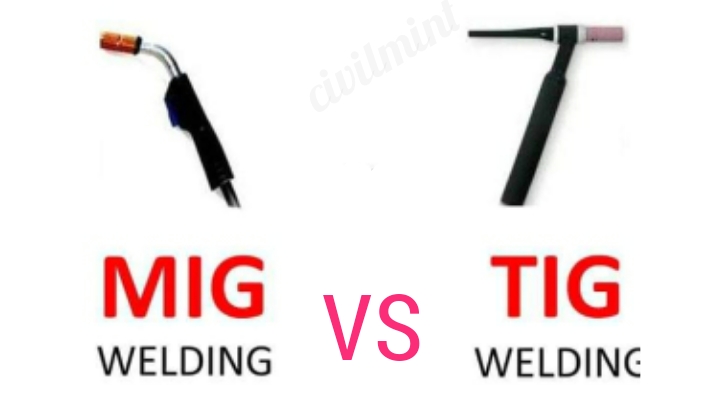In this blog post, we will learn differences between MIG and TIG Welding.
- MIG – Metal Inert Gas
- TIG – Tungsten Inert Gas
Table of Contents
What Is MIG Welding?
The MIG process, which is also known as gas metal arc welding (GMAW), utilizes a semi-automatic or automatic arc to weld. A continuous, consumable wire electrode and a shielding gas are fed through a lead to a welding gun (sometimes called a torch). The choice of wire diameter and composition depends on variables such as the type of metal, its thickness, and the joint configuration.
The MIG welder feeds the solid electrode wire from different size spools to the torch, where it gets consumed. Therefore, one of the key MIG welder settings is the wire feed speed (WFS), which must be adjusted to provide the right amount of weld metal for the intended joint.
The shielding gas used is often a blend of 75% argon and 25% CO2, as this blend promotes weld penetration and reduces bead porosity. However, the choice of shielding gas may vary depending on the material being welded and other factors.
What Is TIG Welding?
TIG welding, also known as gas tungsten arc welding (GTAW), uses a non-consumable tungsten electrode and a separate consumable filler material.
Welders manually feed the filler rod into the weld puddle with one hand while the tungsten electrode creates an arc. The composition and size of the filler rod depend on the specific weld you are performing.
The shielding gas used in TIG welding is typically 100% argon, different from the argon/CO2 blend used in MIG. A foot pedal is often used to adjust the amperage while welding, providing precise control over the heat applied to the metal.
Differences Between Mig Welding And TIG Welding
| MIG Welding | TIG Welding |
|---|---|
| Uses a semi-automatic or automatic arc, with a continuous consumable wire electrode and a shielding gas | Uses a non-consumable tungsten electrode and a separate consumable filler material, controlled by foot pedal |
| Strong welds, but may have more visual defects compared to TIG welds | Considered stronger due to better penetration and fewer defects |
| Faster and more suitable for high production and long runs | Slower due to manual rod feeding and precise control, not ideal for lengthy welds |
| Often uses a blend of argon and CO2, may vary depending on the application | Uses pure argon, sometimes blended with other gases like helium or nitrogen for specific applications |
| Good-looking beads with proper technique, but TIG welds produce cleaner, more professional-looking beads | TIG welds are considered more aesthetically pleasing, especially for visible surfaces |
| Suitable for steel and aluminum, may require extra care when welding stainless steel | Preferred for thin and delicate materials, excellent for welding aluminum and stainless steel |
| Easier to learn and more forgiving, suitable for beginners | More complex and requires practice, considered more advanced, best for experienced welders |
| Generally less expensive, both in terms of equipment and materials | Higher initial cost, slower process, and more expensive, but can achieve high-quality results |
| Thicker stock, long runs, production work, less experienced welders | Thin material, non-ferrous metals, bench or shop work, fine or delicate work, experienced welders |
Conclusion
TIG and MIG welding each have their strengths, and the better choice depends on specific factors. MIG welding is cost-effective and fast for steel and aluminum, while TIG welding creates precise, attractive welds with good penetration, especially for pipe joints, thinner materials, and aluminum/stainless steel work.
Read Also: Symbols Used In Welding
MIG welding works well for low-cost, high-production needs, but it may not be the top choice for stainless steel or when aesthetics are vital. On the other hand, TIG welding provides fine-looking beads and strong penetration, making it ideal for exposed bead applications and critical joints, but it requires experienced welders and comes at a higher cost.

